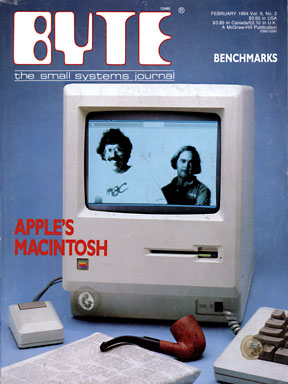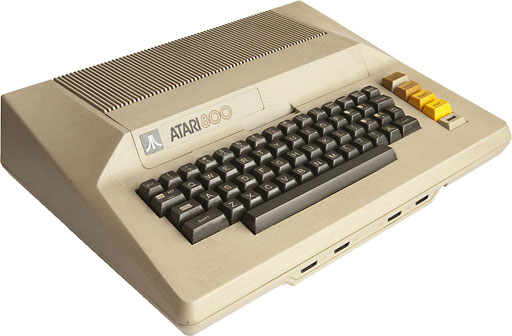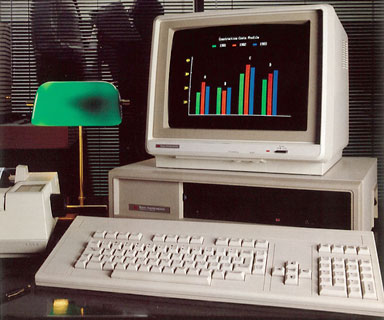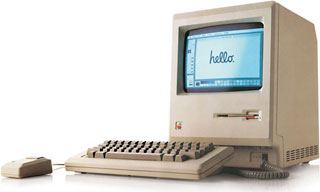On January 24, 1984, Apple announced the Macintosh to its Board of Directors – and to the world. The tiny computer was a radical departure from the large Lisa with it’s 12″ screen, just as Lisa itself had been a huge departure from the Apple II series and the growing family of MS-DOS computers on the market.
The PC Market
 But before we look at the Macintosh, let’s look at the PC market in early 1984. The February 1984 issue of Byte magazine featured the Macintosh on the cover, an ad for Apple’s ImageWriter printer was inside the front cover, and an editorial decrying the creativity lost in the quest for compatibility was on page 4.
But before we look at the Macintosh, let’s look at the PC market in early 1984. The February 1984 issue of Byte magazine featured the Macintosh on the cover, an ad for Apple’s ImageWriter printer was inside the front cover, and an editorial decrying the creativity lost in the quest for compatibility was on page 4.
 Glancing through the ads, we see Commodore, Atari, and Apple still selling 6502-based computers, Radio Shack selling TRS-DOS and MS-DOS machines, lots of CP/M systems still on the market, and a growing number of IBM compatible computers.
Glancing through the ads, we see Commodore, Atari, and Apple still selling 6502-based computers, Radio Shack selling TRS-DOS and MS-DOS machines, lots of CP/M systems still on the market, and a growing number of IBM compatible computers.
The back cover contains an ad for the Tandy TRS-80 Model 2000, perhaps the only PC ever designed around the 80186 processor. Tandy claimed the 8 MHz true 16-bit CPU was a big improvement over the 4.77 MHz 8088 (with its 8-bit bus) that IBM used. And for just $1,500 extra, you could buy the Model 2000 with a 10 MB hard drive.
 Texas Instruments was pushing its Professional Computer, an MS-DOS machine with a better keyboard than IBM’s, higher capacity floppies than IBM, more memory expansion space than IBM (768 KB vs. 640 KB), better standard graphics than IBM, and a better CPU than IBM’s PC, Intel’s 16-bit 8086 instead of the 8088, which used an 8-bit bus. Of course, all those improvements made this MS-DOS computer less than 100% IBM compatible.
Texas Instruments was pushing its Professional Computer, an MS-DOS machine with a better keyboard than IBM’s, higher capacity floppies than IBM, more memory expansion space than IBM (768 KB vs. 640 KB), better standard graphics than IBM, and a better CPU than IBM’s PC, Intel’s 16-bit 8086 instead of the 8088, which used an 8-bit bus. Of course, all those improvements made this MS-DOS computer less than 100% IBM compatible.
 Heathkit was pushing the H-100, their kit version of the Zenith Z-100 that Byte columnist Jerry Pournelle loved (especially the keyboard) and the US Navy bought a lot of (I once worked in a Heath-Zenith store in Virginia Beach, Virginia – it’s amazing how dusty a shipboard computer can get after a few years). The Z-100’s claim to fame was an Intel 8085 for CP/M software along with an 8088 for MS-DOS.
Heathkit was pushing the H-100, their kit version of the Zenith Z-100 that Byte columnist Jerry Pournelle loved (especially the keyboard) and the US Navy bought a lot of (I once worked in a Heath-Zenith store in Virginia Beach, Virginia – it’s amazing how dusty a shipboard computer can get after a few years). The Z-100’s claim to fame was an Intel 8085 for CP/M software along with an 8088 for MS-DOS.
Creativity vs. Compatibility
MS-DOS was winning mindshare, since it drove both the 100% IBM compatible computers and the semi-compatible not-quite-clones.
An interesting failure of the era was the Dimension 68000, which contained “the microprocessors found in all of today’s popular personal computers.” Apparently, getting the 6502, Z-80, 8088, and 68000 to behave with each other was more than Micro Craft could pull off, and I don’t believe the computer ever hit the market.
One more interesting historical footnote before we look at the Macintosh: the IBM CS-9000 Lab Computer was also featured in this issue of Byte. What sets it apart is that it was not based on any Intel chip, but on the same 68000 found in Lisa and Macintosh.
The Macintosh
That was the computer market in early 1984. Most computers, even DOS ones, shipped with 64 KB or 128 KB of memory and had one or two 5.25″ floppy drives. Hard drives, when available, where $1,500 options.
The Macintosh was different. First, there was the mouse, just like Lisa had. In fact, Apple was so adamant that you use the mouse that the original Macintosh keyboard had no arrow keys. (The Ctrl key was also a later innovation.)
was different. First, there was the mouse, just like Lisa had. In fact, Apple was so adamant that you use the mouse that the original Macintosh keyboard had no arrow keys. (The Ctrl key was also a later innovation.)
Then there was that 3.5″ floppy drive storing 400 KB of date – 25% more than the 320 KB 5.25″ floppy disks in the IBM world.
But when you turned it on, the Macintosh showed it’s greatest difference, a graphical user interface (GUI). Although similar to the interface of Lisa, the Mac used square pixels instead of rectangular ones, making it far easier to accurately map graphics to the screen.

A glance at the screen shot of MacWrite looks remarkably familiar. There’s the menu bar we all know and love: Apple, File, Edit, Search, Format, Font, and Style, along with pull-down menus. The menu bar clock and heirarchical menus would come later, but you’d certainly find the experience comfortably familiar.
The 8 MHz 68000 processor was 60% faster than the 5 MHz one found in Lisa, so the Mac was pretty fast in its day. (As noted above, the Tandy Model 2000 used a cutting edge 8 MHz 80186 CPU, which was about equal in power to the 8 MHz 68000.)
Memory prices were a limiting factor, which is the main reason the original Macintosh shipped with 128 KB instead of 256 KB. This probably shaved $200-400 from the retail price!
Apple sore of cheated there, building huge portions of optimized code into a 64 KB ROM that didn’t tie up expensive RAM. This included routines for sound, drawing text, doing graphics, and more, so programmers didn’t have to reinvent these procedures and could write more compact code.
The Mac was essentially a 192 KB computer where 64 KB was already programmed – or at least that was the spin Apple tried to put on it. On the downside, the memory mapped video used up a precious 22 KB of RAM, leaving only 106 KB of memory available for software and data.
As for expansion slots, Apple claimed the “high speed serial bus” would provide all the expansion the Mac would ever need. The RS-422 serial ports support 230.4kbps as shipped from the factory, but it could be externally clocked to four times that speed, something that LocalTalk accelerators would take advantage of in the future.
Still, the original Mac had its limitations. One floppy drive wasn’t enough, unless you had the patience to shuffle 400 KB disks frequently, so the external floppy became a popular accessory. The same ImageWriter printer that worked with the Apple II line could print Mac graphics beautifully, so that also became a very popular part of the Macintosh system. (BTW, I can’t find any mention of laser printers in this issue of Byte.)
Apple didn’t introduce the Macintosh all by itself – at the same January 24 meeting, it unveiled a less expensive Lisa, the Lisa 2. The new Lisa used the same 3.5″ disk as the Mac and could run either the Lisa OS or the Mac OS. It shipped with 512 KB of memory and was even available with a 10 MB hard drive. In fact, only the Lisa and Lisa 2 had enough memory for anyone to do program development for the RAM-limited Macintosh – and all the Mac software run on the Lisa 2 could automatically take advantage of the extra memory.
Realizing the limitations of the 128 KB Macintosh and seeing RAM prices drop, Apple introduced the Fat Mac with 512 KB of memory in September. The original Mac, retroactively called the 128K, remained on the market until October 1985, leaving the Mac 512K as the only model until January 1986.
Other Developments
MacWrite and MacPaint sofware came bundled with the Macintosh, and PowerPoint was developed by Forethought for the Mac in 1984. (In 1987, Microsoft acquired Forethought and made PowerPoint its own.)
On the DOS side, IBM introduced the first 80286-based PC during 1984, running at 6 MHz and introducing high density 1.2 MB 5.25″ floppy disks. Competitors soon upped the ante to 8 MHz – the same clock speed as the Macintosh – but that’s another chapter.
Next – 1985: Word, Excel, PageMaker, and the LaserWriter
Keywords: #mac128k #mac512k #fatmac
Short link: http://goo.gl/E9heTX

